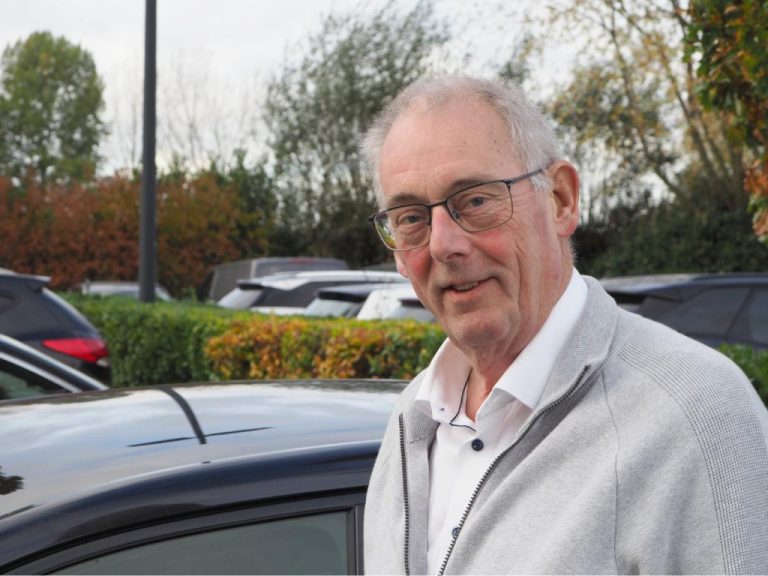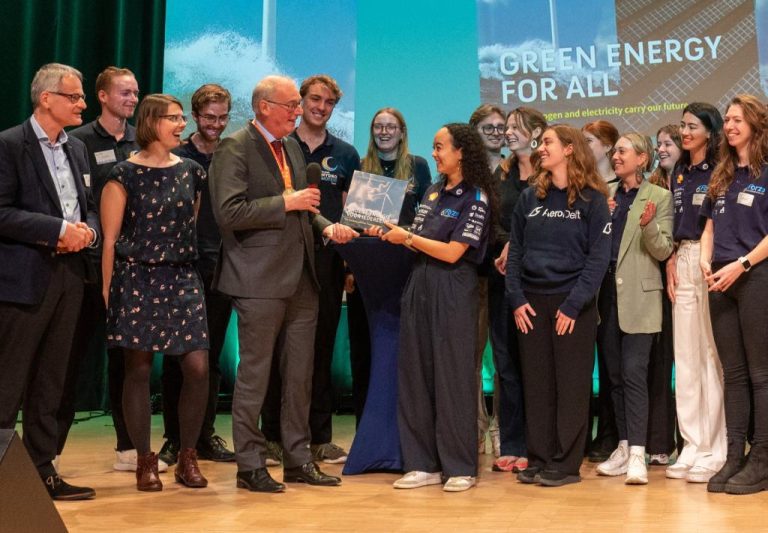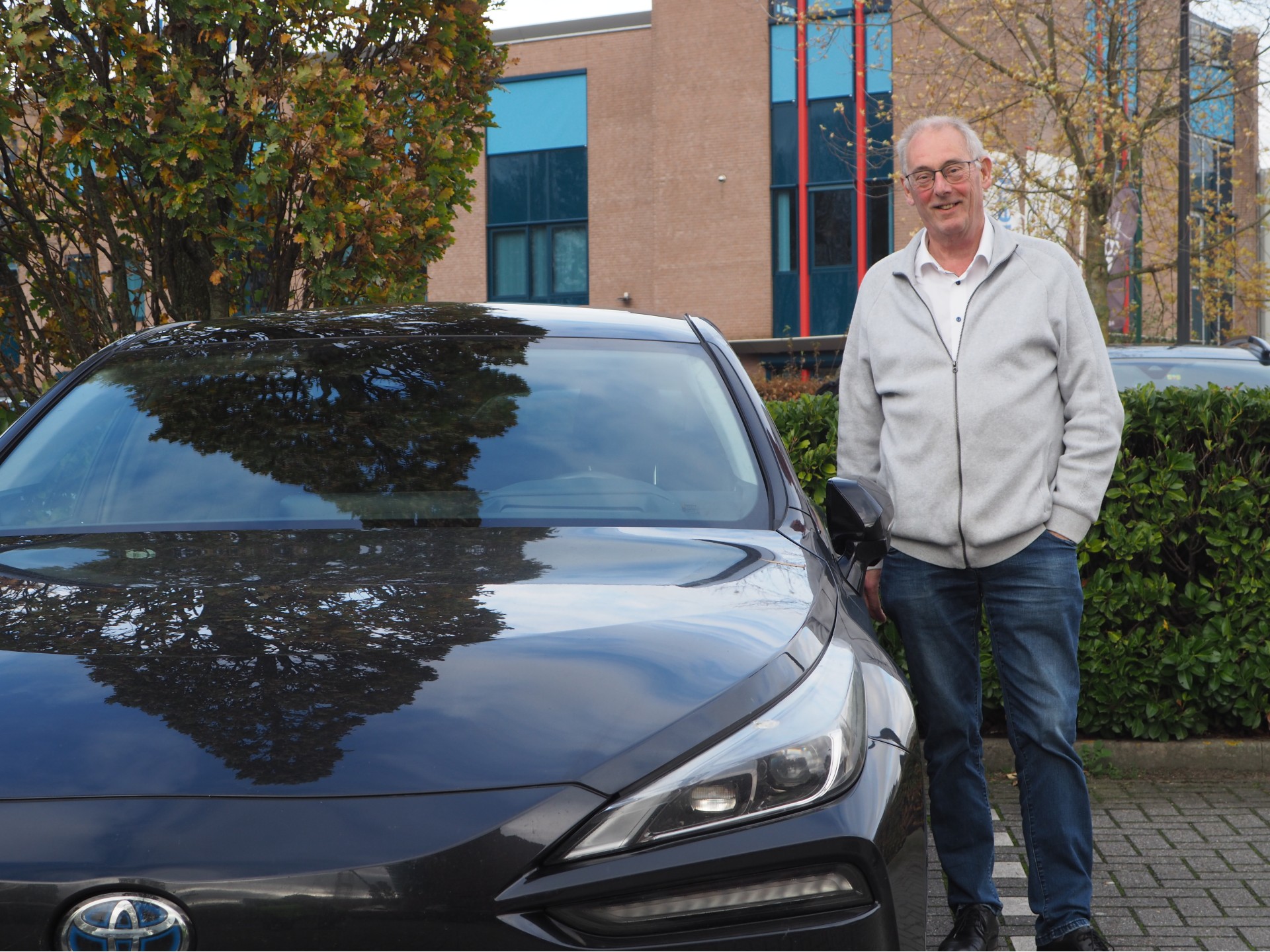Hydrogen Professor Ad van Wijk bid TU Delft farewell with a symposium, farewell speech, and a book on energy. Delta asked him about the origins of his vision on hydrogen.
Ad van Wijk is one of 357 people driving on hydrogen in the Netherlands. (Photo: Jos Wassink)
Ad van Wijk, The Hydrogen Ambassador, celebrated his farewell as an Endowed Professor of Future Energy Systems at the Faculty of Technology, Policy and Management (TPM). One week later he drove his Toyota Mirai hydrogen car to the Van der Valk Hotel in Houten for a farewell interview. The most important question was when and where the idea of green hydrogen as an important element in a sustainable energy system arose.
‘Electricity and hydrogen are the major zero carbon energy carriers’
At your farewell as Professor of Future Energy Systems, you showed a blueprint for a sustainable energy system for 2100. Your book, ‘Groene Energie voor Iedereen’ (green energy for everyone), shows a clean energy future with hydrogen and electricity. Can it really be that easy?
“You summarise it really succinctly, but electricity and hydrogen really are the major zero carbon energy carriers of the future. We will have to use them to transport sustainable energy around the world. For long distances this will mostly be with hydrogen, and regionally, with electricity. At the local level, one option could be heating through a heating grid,” explained Van Wijk.
Green hydrogen plays a central role in your sustainable energy system. How and when did you come up with the idea of green hydrogen?
“In 2016 the Noordelijke Innovation Board (an organisation that works to speed up the economy in the north of the Netherlands, Eds.) asked (in Dutch) me for advice on what the provinces of Friesland, Groningen and Drenthe could do to make the energy system more sustainable. About 30,000 people work directly or indirectly in the gas industry there, so it is of major economic value. I had once converted a methanol factory into a biomethanol factory there. This process runs on hydrogen. It was there that I came up with the idea of replacing natural gas with hydrogen. You can then reuse both the pipelines and can retain the people. There is a large ecosystem for gas in the north, be it natural gas or hydrogen gas.”
‘The more people I spoke to, the greater the support’
Did you have a eureka moment then?
“I would not call it that. I sought contact with the people involved and they thought it was a great idea. The more people I spoke to, the greater the support. I drafted the plan in a book entitled The Green Hydrogen Economy in the Northern Netherlands in 2017.
How was the book received?
“One journalist referred to it as ‘a megalomaniac plan’. I gave a lot of presentations about it. During one of them I met Sandor Gaastra, the General Secretary of the Ministry of Economic Affairs and Climate. The hydrogen story was new for him. It then became a topic of interest in politics. The same goes for Europe too in fact.”
How did hydrogen end up on the European agenda?
“In December 2016 we took the plan for a green hydrogen economy in North of the Netherlands to Maroš Šefčovič, the European Commissioner for Energy at the time. It was a historic meeting. You normally just have 30 or 40 minutes in which to talk to someone like that, but he had invited several members of his Cabinet. We were there for two hours explaining the role of green hydrogen in a sustainable energy system. Later, the plan led to an EU subsidy being given for the first Hydrogen Valley in North Netherlands.”
How did you even come into contact with Šefčovič?
“Coincidence. The Director of the Noordelijke Innovation Board is Denisa Kasová, a woman from Slovakia. She knew him and arranged a meeting. In just one telephone call we went from Groningen to Europe. But as hydrogen was so unknown, I thought I would have to explain why hydrogen is such an important element in the energy transition. I did this in a report entitled Hydrogen – the bridge between Africa and Europe.”
How was it received?
“When the new European Commissioner took office, I sent it to Diederik Samson and Frans Timmermans. (Timmermans took office as the EU Climate Commissioner on 2 December 2019 with Diederik Samsom as his Head of Cabinet, Eds.). In his hearing at the European Parliament, Timmermans said that Europe could import hydrogen from North Africa through pipelines. This brought green hydrogen directly to the attention of the EU. I wrote a policy advisory in which I gave a target of two times 40 gigawatt of electrolysers by 2030. It was used to inform a European hydrogen strategy that became part of the Green Deal.”
But looking at the figures now, not even 2% of the energy comes from hydrogen, while 95% is still based on fossil fuels. I would think that we will never get there, but you have no doubts?
“Let me explain. Hydrogen is only 2% of all energy consumption as hydrogen is currently mostly used as a raw material in the chemical industry, for fertilisers and in refineries. It is hardly used as an energy carrier.”
‘It’s all there, it just needs to be scaled up and adapted’
“The same goes for electrolysers. These are now used to produce chlorine. But given the existing electrolyser manufacturers, we could rapidly expand the production capacity of hydrogen electrolysers. It is not a new technology. Electrolysers, gas pipelines, gas storage: it’s all there, and we can reuse it for hydrogen, it just needs to be scaled up and adapted.”
Could it also be done more smartly and efficiently?
“Of course. The technology can be improved in all sorts of ways. But the biggest improvement would actually be the mass production of cells and stacks (for electrolysers, Eds.) which would make the technology cheaper, just as happened with solar cells. The technology system is the same, nothing needs to run and it does not involve high temperatures. This is why I believe that a strong scaling up of green hydrogen production is possible.”

Between 2011 and 2023, Ad van Wijk was associate professor of future energy system at TU Delft. (Photo: Jos Wassink)
What do you see as the biggest hurdles for sustainable energy provision in 2050?
“Assessments always look at energy production and needs, but never at transport and storage. This is their Achilles’ heel. Transport and storage currently make up about 10% of an energy system’s costs, but a sustainable energy system could bring this up to 50% because of conversions, transport and storage.”
“You already see this in the electricity grid. We should have seen that the capacity is too small for the energy transition. Investments are now being made in extending the electricity grid (in Dutch), but we started too late and are reaching the limits. The Government is responsible for the infrastructure.”
How is research on green hydrogen going at TU Delft?
“Much research is being done on its various components. Zofia Lukszo (Faculty of TPM, Eds.) is doing research on the transport of hydrogen and systems integration. Hadi Hajibeygi (Faculty of Civil Engineering and Geosciences, Eds.) is doing research on hydrogen storage in subsurface salt domes. Willem Haverkort (Faculty of Mechanical, Maritime and Materials Engineering, Eds.) and Ruud van Ommen (Faculty of Applied Sciences, Eds.) are working on improving electrolysis.”
Who will take over the leadership role?
“Look, you should never think that you are unique. Hydrogen projects will be carried out in one way or another by other people.”

The farewell symposium saw a symbolic handing over of the book to the next generation personified by Eva van der Dijs, Team Manager Forze Hydrogen racing. (Photo: TU Delft)
- Ad van Wijk, Els van der Roest, Jos Boere: Green energy for all – how hydrogen and electricity carry our future, self-published, 2023
- Symposium ‘Green energy for all’
- Farewell speech ‘A sustainable energy supply for everyone’
Kornelis Blok about Ad van Wijk
“Success has many fathers,” says Kornelis Blok, Professor Emeritus of Energy Systems. He has known Ad van Wijk since they both studied physics in Utrecht. Blok explained that research on hydrogen as an energy carrier, for cars for example, has been going on for decades. In the case of cars, lithium batteries were seen as a better option at the time though. There has also been much research on hydrogen storage. This could be in vehicles or in underground facilities.
“Hydrogen produced from natural gas, was always an expensive source of energy. In around 2010, Ad (van Wijk, Eds.) was one of the first people to see that solar and wind energy was becoming ever cheaper and could become a source of affordable sustainably produced hydrogen, otherwise known as green hydrogen. He was one of the first to put green hydrogen on the map in the Netherlands and later in Europe. Everyone else built on the work of their predecessors, but Ad was definitely a pioneer in green hydrogen.”
Do you have a question or comment about this article?
j.w.wassink@tudelft.nl


Comments are closed.